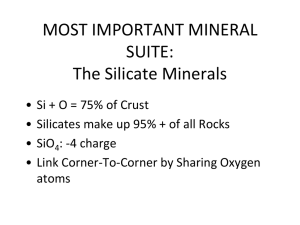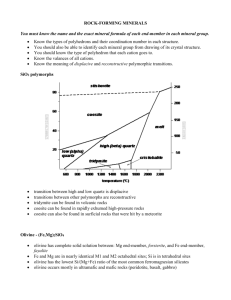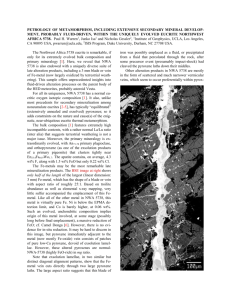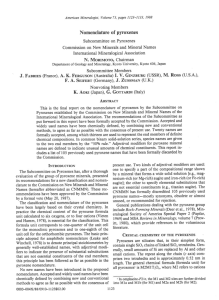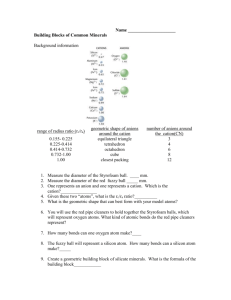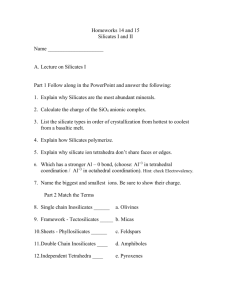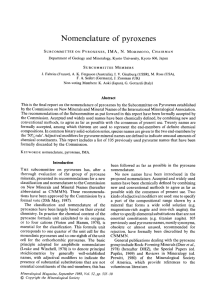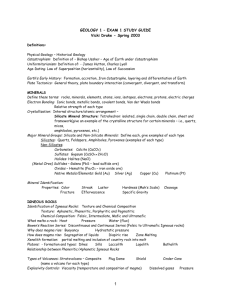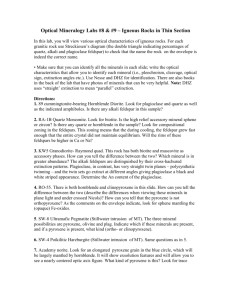NOMENCLATURE OF PYROXENES
advertisement
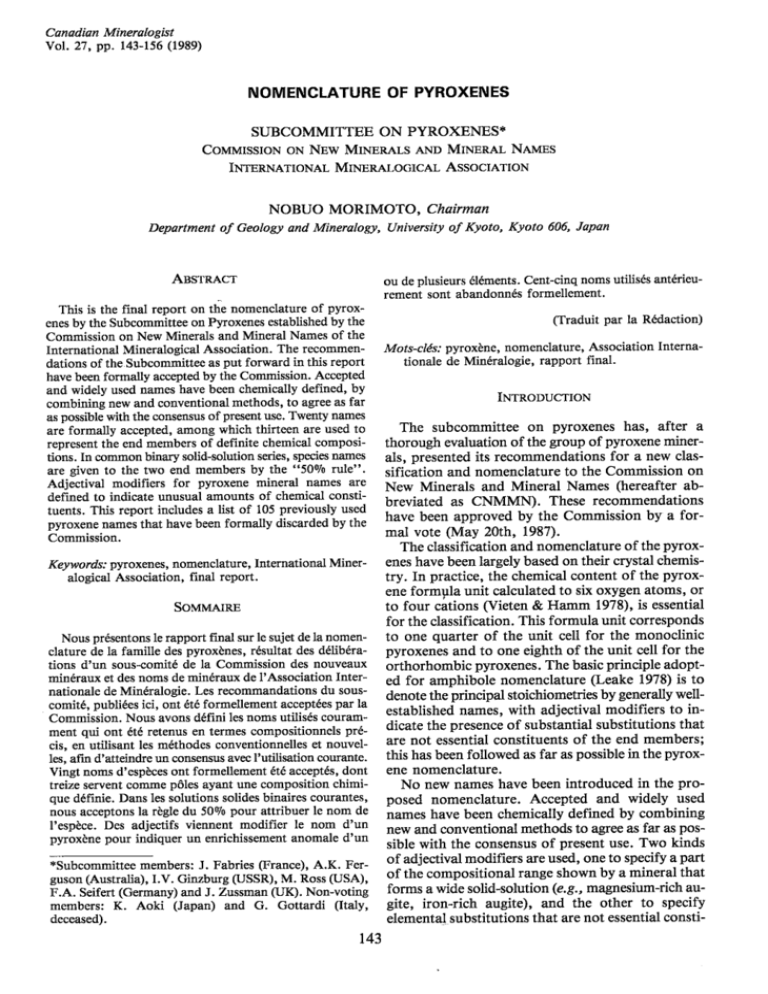
Canadian Mineralogist
Vol. 27, pp. 143-156 (1989)
NOMENCLATURE OF PYROXENES
SUBCOMMITTEE
COMMISSION
ON PYROXENES*
ON NEW MINERALS
INTERNATIONAL
AND MINERAL
MINERALOGICAL
NAMES
ASSOCIATION
NOBUO MORIMOTO, Chairman
Department of Geology and Mineralogy, University of Kyoto, Kyoto 606, Japan
ABSTRACT
ou de plusieurs elements. Cent-cinq noms utilises anterieurement sont abandonnes formellement.
This is the final report on the nomenclature
of pyroxenes by the Subcommittee
on Pyroxenes established by the
Commission
on New Minerals and Mineral Names of the
International
Mineralogical
Association.
The recommendations of the Subcommittee
as put forward in this report
have been formally accepted by the Commission.
Accepted
and widely used names have been chemically defined, by
combining new and conventional
methods, to agree as far
as possible with the consensus of present use. Twenty names
are formally accepted, among which thirteen are used to
represent the end members of definite chemical compositions. In common binary solid-solution series, species names
are given to the two end members by the "50070 rule".
Adjectival
modifiers
for pyroxene
mineral
names are
defined to indicate unusual amounts of chemical constituents. This report includes a list of 105 previously used
pyroxene names that have been formally discarded by the
Commission.
Keywords: pyroxenes, nomenclature,
International
alogical Association,
final report.
Miner-
SOMMAIRE
Nous presentons Ie rapport final sur Ie sujet de la nomenclature de la famiIIe des pyroxenes, resultat des deliberations d'un sous-comite de la Commission des nouveaux
mineraux et des noms de mineraux de I' Association Internationale de Mineralogie. Les recommandations du souscomite, publiees ici, ont ete formellement acceptees par la
Commission. Nous avons defini les noms utilises couramment qui ont ete retenus en termes compositionnels precis, en utilisant les methodes conventionnelles et nouvelles, afm d'atteindre un consensus avec I'utilisation courante.
Vingt noms d'especes ont formellement ete acceptes, dont
treize servent comme poles ayant une composition chimique definie. Dans les solutions solides binaires courantes,
nous acceptons la regie du 50% pour attribuer Ie nom de
l'espece. Des adjectifs viennent modifier Ie nom d'un
pyroxene pour indiquer un enrichissement anomale d'un
*Subcommittee members: J. Fabries (France), A.K. Ferguson (Australia), LV. Ginzburg (USSR), M. Ross (USA),
F.A. Seifert (Germany) and J. Zussman (UK). Non-voting
members: K. Aoki (Japan) and G. Gottardi (Italy,
deceased).
143
(Traduit par la Redaction)
Mots-eMs: pyroxene, nomenclature, Association Internationale de Mineralogie, rapport final.
INTRODUCTION
The subcommittee on pyroxenes has, after a
thorough evaluation of the group of pyroxene minerals, presented its recommendations for a new classification and nomenclature to the Commission on
New Minerals and Mineral Names (hereafter abbreviated as CNMMN). These recommendations
have been approved by the Commission by a formal vote (May 20th, 1987).
The classification and nomenclature of the pyroxenes have been largely based on their crystal chemistry. In practice, the chemical content of the pyroxene formvla unit calculated to six oxygen atoms, or
to four cations (Vieten & Hamm 1978), is essential
for the classification. This formula unit corresponds
to one quarter of the unit cell for the monoclinic
pyroxenes and to one eighth of the unit cell for the
orthorhombic pyroxenes. The basic principle adopted for amphibole nomenclature (Leake 1978) is to
denote the principal stoichiometries by generally wellestablished names, with adjectival modifiers to indicate the presence of substantial substitutions that
are not essential constituents of the end members;
this has been followed as far as possible in the pyroxene nomenclature.
No new names have been introduced in the proposed nomenclature. Accepted and widely used
names have been chemically dermed by combining
new and conventional methods to agree as far as possible with the consensus of present use. Two kinds
of adjectival modifiers are used, one to specify a part
of the compositional range shown by a mineral that
forms a wide solid-solution (e.g., magnesium-rich augite, iron-rich augite), and the other to specify
elemental substitutions that are not essential consti-
144
THE CANADIAN
tuents (e.g., titanian augite). One hundred and five
previously used pyroxene names, mostly synonyms,
and obsolete or almost unused names, have been formally discredited by the CNMMN. General publications dealing with the pyroxene group, e.g., RoekForming Minerals (Deer et al. 1978, denoted DHZ
in the Tables), Special Paper 2 (papike 1969) and
Reviews in Mineralogy 7 (Prewitt 1980), both published by the Mineralogical Society of America, provide references to the voluminous literature.
CRYSTAL
CHEMISTRY
MINERALOGIST
Si4+
6
LOOO
Al3+
Al3+
Fe3+
I
Ti4+
er3+
OF THE PYROXENES
y3+
Pyroxenes are silicates that, in their simplest form,
contain single Si03 chains of linked Si04 tetrahedra.
Generally, small amounts of Si are replaced by'AI
and other small cations. The repeat distance e along
the chain (Z axis) comprises two tetrahedra and is
approximately 0.52 nm in length. The general chemical formula (formula unit) for all pyroxenes*! is
M2MI T206' where M2 refers to cations in a generally distorted octahedral coordination, MI to cations
in a regular octahedral coordination, and Tto tetrahedrally coordinated cations.
Any pyroxene belongs to either the orthorhombic or the monoclinic crystal system. There are two
types of orthorhombic pyroxene: orthopyroxene
(Pbea) and orthopyroxene (Pben)*2. Only the former has been found in nature. Monoclinic pyroxenes
are called clinopyroxenes. Their space groups are
C2/e, P2/e and P2ln, depending on their chemical composition and genetic history.
Throughout this report, the standard pyroxene
formula is used with superscript arabic numerals
(e.g., Fe2+) referring to charges, and subscript
numerals (e.g., Mg0, to numbers of atoms. To derive a pyroxene formula from a chemical analysis, the
calculation should be based on six oxygen atoms
when both Fe2+ and Fe3+ have been determined. In
microprobe analyses only total Fe is determined, and
the option of calculating to four cations should at
least be permitted if not actually preferred. Yieten
& Hamm (1978) showed that calculation to four
cations will be more reliable for the majority of
pyroxenes characterized by electron-microprobe
analysis. Therefore, for electron-microprobe data,
it is recommended that the components be totalled
to six oxygen atoms and four cations by adjusting
the ratios Fe2+IFe3+ , Ti4+/Ti3+, etc.
The standard pyroxene formula M2MI T206 contains two tetrahedral sites. In the allocation of the
cations to obtain a pyroxene formula, the following
procedure is recommended:
1)' Sum T to 2.000 using Si4+, then Al3+, then
Fe3+
.
*See comments at end of text.
Ti3+
.
zr4+
Sc3+
Zn2+
Mg2+
_
_
_
,:.'00
,:.'00
I
II
Mg2+
Fe2+
Fe2+
Mn2+
Mn2+
u+
ea2+
Na+
FIG,I. Flow chart for ideal site-occupancy of cations
among the T, MI and M2 sites of pyroxenes. Only
representative cations are included. Arrows indicate
order of filling of sites. Real site-occupancy usually
differs slightly from the ideal site-occupancy.
'.rABLE1. FOUR
COUPLED
SUBsn'l'U'rIONS
OF PYROXENES
IN
'l'HE S'.rANDARDFORMULA R2+R2+R~+06
Substitution
site
M2
M1
standard
R2+
R2+
2R4+
(R+)
(R3+)
2R4+
substitution(1)
substitution(2) (R+) R6;s(Rg;S)
substitution(3) R2+
(R3+)
'.r
2R4+
(R3+)R4+
examples
~::~;3+
Na_cr3+
Na_Sc3+
Na_(U4+/2)
AI-AI
Fe3+-AI
cr3+_AI
2) Sum MI to 1.000 using all Al3+ and Fe3+ in
excess of that used to fill the T sites. If there is
insufficient Al3+ and Fe3+ to sum to 1.000, then
add Ti4+, Cr3+, y3+, Ti3+, Zr4+, Sc3+, Zn2+,
Mg2+, Fe2+ and, finally, Mn2+, until the sum is
1.000.
NOMENCLATURE
3) Sum M2 using all Mg2+, Fe2+ and Mn2+ in
excess of that used to fill the Ml sites. Then add
Li+, Ca2+ and Na+ so that the sum becomes
1.000 or close to it. If the sum is far from 1.000,
one must be suspicious about the results of the
analysis.
A flow chart (Fig. I) gives a diagrammatic representation of the site allocation of the principal cations
in pyroxenes. However, because the distribution of
cations among the MI, M2 and T sites in a given
pyroxene is partly a function of temperature, the
accurate site-occupancy must be determined by structure determination. The site-occupancy given in
Figure 1 is called ideal site-occupancy to distinguish
it from real occupancy. A method for classifying
pyroxenes by their ideal site-occupancies has been
proposed by Bokii & Ginzburg (1985). In the present
classification of pyroxenes, the MI and M2 sites are
considered together as a single M site in order to
avoid the possible difference between the real and
ideal site-occupancies.
Starting from the most common pyroxene formula, M2(R2+)MI(R2+)Ti2R4+)06'
four coupled
substitutions are possible if one assumes more than
one R4+ in the T site. They are listed in Table I,
where the elements in parentheses are coupled substitutions.
Substitution (1) encompasses the end members
jadeite (NaAISi206), aegirine*3 (NaFe3+ Si206),
kosmochlorM
(NaCr3+ Si206), and jervisite
(NaScSi20J. Substitution (2) results in components
such as NaF~~Ti6~SiP6' and is less important than
the other substitutions.
In substitution (3) the AI-AI couple is often
referred
to as "Tschermak's
component";
CaAlAISi06, in particular, is called "calcium
Tschermak's
component".
Substitution
in
esseneite*5 (CaFe3+ AISi06) is obtained by this type
of substitution. This substitution is also important
in "fassaite"*6.
Substitution
resulting
in
CaTi3+ AISi06 was reported by Dowty & Clark
(1973) and Mason (1974) in pyroxene from the
Allende meteorite (Table 3, No.4). In substitution
(4), the component CaMgo.5Ti~~AlSi06 is found in
some pyroxenes. There are a few instances of the
component of substitution (2) or (4) amounting to
nearly 50%, as described later (Table 3). However,
no particular names are given for the end-member
components of substitutions (2) and (4).
MINERAL
NAMES
145
OF PYROXENES
the solid-solution series into ranges with specified
compositions and names. Wherever there is a complete solid-solution series between two end members,
it is customary in mineral nomenclature to use only
two names, and the division between them should
TABLE
2.
ACCEPTED
mineral
PYROXENE
AND
THEIR
CHEMICAL
composition main composition
as end-member as solid solution
names
I. Mg-Fe pyroxenes
(En)(1)
1. enstatite
2.
MINERAL
NAMES
SUBDIVISIONS.
Mg2Si206
(2)
ferrosilite{Fs)
space
group
Fe~+Si206
3. clinoenstat!te
4.
clinoferrosil,ite
5. pigeonita
II.
Mn-Mg pyroxenes
6.
donpeacorite
7. kanoite
III.
MnMgSi206
(Ra) (3)
(Mn,Mg)MgSi206
~
(Mn,Mg)MgSi206
R,21/£
Ca pyroxenes
8. diopside
(Di)(4)
CaMgSi206
9. hedenbergite(Hd)
CaFe 2 +S1206
(5)
(Ca,Mg ,Fe)
10.
augite
11.
(6)
johannsenite(Jo)
CaMnSi206
12.
petedunnite{pe)
CaZnSi206
13.
esseneite(Es)
IV.
Ca-Na
} Ca(Mg,Fe)Si206
(7)*1
(8)*2
2512°6
CaFe3+AlSi06
pyroxenes
14.
omphacite
15.
aegirine-augite
(Ca,Na)
{R2+ ,AI )S1206
£2/£,E.2/I!.
(Ca,Na)
(R2+ ,Fe3+)Si206
£2/£
V. Na pyroxenes
16.
jadeite (Jd)(9)
17.
aegirine
NaAISi20S
}
(Ae.) (1 0)
NaFe3+Si206
(11)
Naer3+Si206
18.
kosmochlor{Ko)
19.
jervisite
VI.
Li
(Je) (12)*3
NaSc3+Si206
pyroxene
spodumene (Sp)(13)
20.
Na(Al,Fe3+)Si206
LiA1Si206
*Name, abbreviation
and composition are given for any pyroxene
that
is used as an end member of a pyroxene
solid
solution;
such end members are numbered between parentheses from 1 to
13.
Main compositions
are given
for solid
solutions.
*1
has been
Petedunnite
(Essene
& Peacor
by electron
microprobe
ha;: the3~mposition (caO.92-
determined
1987)
to
NaO. 06MnO. 02) (Zno. 37MnO.19FeO.19Feo.12M90.14)
This mineral
was approved
as
AlO.06)06'
by the CNMMN, IMA, in 1983.
(Silo
a valid
94species
OF THE PYROXENES
*2
The pyroxenes form extensive solid-solutions by
various types of ionic substitutions, some of which
are described above. To cope with the problem of
pyroxene nomenclature, it is necessary to subdivide
Esseneite has
ca
Twenty mineral names and their grouping
~+peacor
been determined by electron
composition
1987)
to have
(FeO. nMgO.16A10.
04TiO.
~:
03FeO. 02)
(Sil.19AlO.
microprobe
(cal.OlNaO.Dl)81)
°6. 00'
This mineral was approved as a valid species in 1985.
*3
Jervisite has been
(Mellini
et
al.
determined
1982)
to
have
by electron
microprobe
the composition (NaO.43-
CaO.31Fe~:14
00.12)
(ScO.66Fe~:15M90.19)Si206'
mineral
was approved as a valid
species in
This
1982.
(Cos-
146
THE CANADIAN
be at A soBso (the "500/0 rule"). However, this
"50% rule" cannot be applied rigorously to the large
groups of pyroxenes that show wide ranges of coupled substitutions. This is particularly so when the
minerals concerned are abundant and widespread,
and have a historically established nomenclature in
mineralogical and petrological circles. Taking this
situation into consideration, 20 accepted and widely
used names have been adopted as species names of
the pyroxenes (Table 2).
The definition of the pyroxene species has been
based on 13 end members, or chemical components
listed in Table 2, and the component Ca2Si20:
(WO)*7. These end members are given the name of
the mineral whose composition they most closely
approximate. The 20 pyroxene species are grouped
into 6 chemical subdivisions on the basis of the cation
occupancy of the M2 sites and crystal-chemical
similarity. This classification is a slight modification
of the widely used scheme proposed by Deer et at.
(1978).
For the precise classification of the pyroxenes into
20 mineral species, however, the following characteristics of the pyroxenes must be considered. Firstly,
the Mg-Fe pyroxenes and some of the Ca pyroxenes
are the most common rock-forming pyroxenes and
form wide solid-solutions that cover the pyroxene
quadrilateral of the ternary system Ca2Si206(Wo) Mg2Si206(En) - Fe2Si206(Fs). Therefore, these
pyroxenes are better treated together as the Ca-MgFe or "quadrilateral"
pyroxenes. Secondly, Na
pyroxenes form continuous solid-solution series with
the Ca-Mg-Fe pyroxenes, forming the Na-Ca pyroxenes. Thirdly, donpeacorite and kanoite (Mn-Mg
pyroxenes), johannsenite, petedunnite and esseneite
(Ca pyroxenes), and spodumene are rare in occurrence and unique in chemistry. For simplicity they
are treated together as 'other' pyroxenes*8.
All the pyroxenes are thus divided into four chemical groups for the purpose of broad classification:
Ca-Mg-Fe pyroxenes (Quad, 8), Ca-Na pyroxenes
(Ca-Na, 2), Na pyroxenes (Na, 2) and 'other' pyroxenes (Others, 8). The abbreviation of the group and
the number of accepted species are given between
parentheses. Quad represents "quadrilateral" for the
Ca-Mg-Fe pyroxenes. The four chemical groups are
further divided into 20 mineral species by using 12
components (using the Wo component for Di and
Hd components). The composition ranges for the
accepted names will be given later.
The pyroxene names may be qualified by one or
more adjectival modifiers according to definite rules
d~cribed later to specify important (though relatively
mmor) departures from the composition ranges.
Where the composition range of the mineral species
is large, as in augite, one or more adjectival modifiers are used to specify the composition more clearly
(e.g., sub calcic augite, Fe-rich augite).
MINERALOGIST
Application
of 50% rule
The 50% rule has been applied to complete solidsolution series between two end members as far as
possible. They are the Mg-Fe pyroxene series
(enstatite-ferrosilite
and
clinoenstatiteclinoferrosilite series), Ca pyroxene series (diopsidehedenbergite series) and Na pyroxene series Gadeiteaegirine series). Subdivision names applied to the
intermediate solid-solution ranges, such as bronzite,
hypersthene, and eulite of the enstatite-ferrosilite series, and salite and ferrosalite of the diopsidehedenbergite series, have been discarded. However,
the 50% rule was not applied rigorously to the CaMg-Fe pyroxenes and Na-Ca pyroxenes. The widely
accepted terms such as augite, pigeonite, omphacite
and aegirine-augite*9 have been retained.
Gem names of spodumene
Two names, hiddenite and kunzite, often are used
respectively for (pale) emerald-green and lilaccolored spodumene of gem quality. They are notaccepted as formal pyroxene names, but can be used
as varietal gem names.
Relationships
with the pyroxenoids
Pyroxenoids are closely related to pyroxenes in
that they have a similar type of chemical composition and a structure that also consists of Si03 single chains. However, the repeat of the chains, which
is two Si04 tetrahedra in the pyroxenes, is three or
more Si04 tetrahedra in the pyroxenoids. Though
the tetrahedral sites are mostly occupied by Si ions,
the large cations are mostly Ca, Mn and Fe2+ in the
pyroxenoids. The classification and nomenclature of
the pyroxenoids are beyond the scope of this report.
However, the following two points may be noted.
Firstly, there is a polymorphic relationship with some
pyroxenes such as ferrosilite, hedenbergite and
johannsenite. These show pyroxenoid structures at
high temperatures or pressures. Secondly, the wollastonite chemical component (Ca2Si20J is used to
express the composition of the Ca-Mg-Fe pyroxenes,
though wollastonite belongs to the pyroxenoid structural group.
CLASSIFICATION
AND NOMENCLATURE
OF THE PYROXENES
Preliminary classifications; construction of the Q-J
diagram and application of pyroxene data
Before classifying the pyroxenes into the 20
mineral species listed in Table 2, the following procedure is recommended to divide them into four chemical groups: Ca-Mg-Fe pyroxenes (Quad), Na-Ca
pyroxenes (Na-Ca), Na pyroxenes (Na), and other
pyroxenes (Others) (Morimoto & Kitamura 1983).
NOMENCLATURE
147
OF PYROXENES
Q
Q=Ca+Mg+Fe
2+
J =2Na
En,Fs. (Di,Hd), Wo
2.0
1.5
I
I
f
~=0.8
I
0.5
I
I
I
I
Sp
others
--- --0.5
1.0
FIG. 2. Q-J diagram for the pyroxenes, on which the positions of the 13 accepted
end-members have been indicated. Abbreviations
and compositions of the end
members are listed in Table 2.
In this procedure, the pyroxenes are classified by
using the total number of specified cations at the M
(Ml and M2) sites on the basis of six oxygen atoms.
The Ml and M2 sites are considered together as M
sites, without considering the
. site preference of atoms
between the two sites.
The numbers of Ca, Mg, Fe2+ and Na cations in
the M sites are plotted in the Q-J diagram (Fig. 2)
and J = 2Na. The lines
as Q = Ca+Mg+Fe2+
representing the following equations are used to subdivide the Q-J diagram:
(1)
(2)
(3)
(4)
Q +
Q +
J/(Q
J/(Q
J
J
+
+
= 2.0
= 1.5
J) = 0.2
J) = 0.8
The areas corresponding to the Ca-Mg-Fe pyroxenes, Ca-Na pyroxenes, Na pyroxenes and other
pyroxenes are labeled (Fig. 2) Quad, Ca-Na, Na, and
Others, respectively.
In this diagram, J is meant to include the total
number of Na and R3+, usually AI, Fe3+, Cr3+ and
Sc3+, that couple with Na in substitution (1) mentioned in Table 1. Where the coupling substitution
in the pyroxene is not of type (1), but of type (2) or
(3), the J value apparently does not represent the real
numbers of Na and R3+ at the M sites. However,
substitution (3) (e.g., AI-AI) works to move the J
and Q values closer to the origin of the Q-J diagram,
and substitution
(2) (e.g., Na-Ti4+) to move the J
value farther away from the Q axis of ordinates.
Therefore, the effects of substitutions (2) and (3) tend
to cancel each other out in and near the area of Na
pyroxenes. Thus the J (= 2Na) values in the Na-rich
pyroxenes represent, to a good approximation, the
total number of Na and R3+(AI, Fe3+, Cr3+ and
Sc3+) at the M sites.
The boundary Q + J = 2.0 represents the upper
limit of Q+J at the M sites. The boundary
Q + J = 1.5 represents the limit below which more
than half of the MI or M2 sites may be occupied
by ions other than Q and J ions. In this case, the
pyroxenes are considered as belonging to 'Others',
which include the Mn-Mg and Li pyroxenes, johannsenite, petedunnite and esseneite. The third and
fourth equations represent the lines dividing the area
limited by the two above-mentioned Q + J lines into
Ca+Mg+Fe (Quad), Ca-Na and Napyroxenes. The
148
THE CANADIAN
boundaries defined by J/(Q+J) = 0.2 and 0.8 are
used by Deer et af. (1978) and Cameron & Papike
(1981).
Because the Mn-Mg pyroxenes and johannsenite
(Table 2) have Mn ions occupying more than half
of the M2 and Ml sites, respectively, they appear
along the Q axis between 1.0 and 1.5 of the Q values
in the Q-J diagram. Similarly, petedunnite and
esseneite appear along the Q axis with a Q value
between 1.0 and 1.5. Spodumene compositions
cluster at the origin of the Q-J diagram because both
Q and J are zero. The 13 end members (Table 2) and
Wo thus are located in the Q-J diagram (Fig. 2).
Application of this classification procedure to 406
pyroxene compositions presented by Deer et al.
(1978) has shown that most of them, except those
of johannsenite and spodumene, are included in the
area between the lines Q+J = 2.0 and 1.5. Of the
406, the 103 pyroxene compositions selected by
Cameron & Papike (1981), for which the Q values
are less than 1.90 and Mn is less than 0.08 atoms per
formula unit, are plotted in the Q-J diagram of
Figure 3. The 'CaMgTAL' pyroxene (Cameron &
Papike 1981) is included in the Quad area as
MINERALOGIST
described later (Table 3, No.1). Only 20 compositions among 406 plot slightly over the line
Q + J = 2.0, and most of these show unusual total
numbers of cations. The results of the classification
of the pyroxenes into the four chemical groups by
this procedure are in almost complete agreement with
the results obtained by Deer et al. (1978) and by
Cameron & Papike (1981). A few unusual pyroxenes
with Mn less than 0.08 atoms in the chemical formula unit have been found to lie outside the area
between
Q+J
=
2.0 and Q+J
=
1.5 lines in the
2.0 and 1.5 have components
other than Q
Q-J diagram. The classification of these unusual
pyroxenes will be discussed later.
The pyroxenes that plot in the area between
Q+J
=
and J ions at less than 25% of the M sites. Therefore, we can classify such pyroxenes on the basis of
the normalized Q and J components, thereby neglecting the effects of the other components. The following procedures are adopted for further classification:
1) The pyroxenes in the Quad area are classified
on the pyroxene quadrilateral
(Wo-En-Fs
diagram) with normalized Ca, Mg and Fe
(= Fe2+ + Fe3+ + Mn) atomic proportions.
Q
2.0
1.0
o
J
1.0
2.0
FIG. 3. The 103 pyroxene compositions
selected by Cameron & Papike (1981) from
the compilation of Deer et al. (1978), plotted on the Q-J diagram. For these pyroxenes the Q values are less than 1.90, and Mn is less than 0.08 atoms per formula
unit.
NOMENCLATURE
TABLE 3.
a)
ca-rich
CHEMICALCOMPOSITION AIiID CLASSIFICATION
OF EIGHT UNUSUAL PYROXENES.
group related to 83 and 54
1. 320-8
2. 403-3
3. D and S*1
4. T and R*2
5i
1.443
1.506
1.434
1.196
Al
.557
Al
.091
.171
.306
.186
Ti4+
.165
.065
.022
Ti 4+ .111
Fe3+
.128
.159
.218
Ti3+
Mg
.385
.570
.408
Fe2+
.229
Mn
.005
.007
.005
Ca
.992
.975
.979
Na
.006
.007
.002
No.
149
OF PYROXENES
(406-16)
such as 320-8,
etc.
represent
pages and
in DHZ (1978).
Other references
are in text.
With the exception of 320-8
(=-40616),
all
the DHZ analyses
in this table were not
included in the 103 selected analyses of Cameron
& Papike (1981).
All pyroxenes
in the table are
Bhown with their numbers in the Q-J diagram
(Fig. 7).
82,
83 and 84 represent the following
(2), (3) and (4),
components
of substitutions
respectively:
*Numbers
analysis number
2.00
.494
2.00
.000
II
.063
2.00
2.02
2.00
1.61
1.45
J
0.01
0.01
0.00
Na-rich
No.
5i
aluminian
ferrian
diopside
te
(320-8 )
titaniumfassai te
(406-16)
cc~g;~
b)
subsilicic
subsilicic
ti tanian
ferrian
diopside
ti tanauqi
group
.394
2.00
2.00
Component ratios;
subsilicic
ti tanoan
al uminian
1.
pyroxene
fassai
te
titanaugite
(W022En12FS1 0) 4454(Mg) 18S4 (Fe) 16Es1353(AI)
(W026En25FS2) 5353 (Al) 17Es1654 (Mg) 1254 (Fe)
9
2
(Wo22En20Fs2) 4453(AI) 31ES21 54 (Mg) 4
4. 53 (Ti) 3954 (Mg) 22(11'°11 FS9) 2053 (Al) 19
5. Ae46S2(Mg)28S2(Fe)20C./5
P)
*3
6.
rell'.ted to
82
7.
1.994
2.024
2.009
.000
.000
.000
.000
.021
.098
.348
.265
.023
.227
.104
.458
.728
.192
.031
.070
.113
2.00
.070
2.00
.420
.356
.003
.006
.021
.011
.933
.872
.794
.610
Ca
.083
.155
.152
.361
0.64
2.00
A represents
*5 have W1usual
structUre.
ti tanian
magnesian
ferroan
aegirine
calcian
ferroan
aegirine
titanian
aegirineaugite
ti tanian
ferroan
omphacite
Names
in
litera-
ti tanian
aegirine
aegirine-
ti tanian
aegirine-
ti tanian
ferro-omphacite
te
minor
metal
components,
some of which
ratios for the pyroxene
1.22
Mineral
names
augi
1974) .
Cameron & Papike (1981),
Table
A3, Analysis
*3 320-8 and 406-16.
Table 2, Analysis 5
*4 curtis & Gittins (1979),
for No. 7 and Table
5, Analysis 5 for No.8.
0.89
1.59
1.74
(1980),
Table
1 for
fassaite.
& Robinson
(1977),
Table 3, Analysis 1
*2 Tracy
for pyroxene for the Allende meteorite
(Mason
.006
.009
0.34
92524A4
(Ae19Jd1 OFS12W08En2) 51 52 (Fe) 4252 (Mg) 4"3
(Jd35Ae3W018Fs15En7) 7852 (Fe) 1452(Mg) fl\2
*1 Devine & 5J:gurdsson
.168
1.98
Mn
II
8.
(Ae73Jd2W08Fs6En3)
2.01
2.02
.032
Na
ture
a
0.00
subsilicic
alwninian
ferrian
diopside
6. C and G*4
1.87
54",
3.
.150
J
and
R ions
1.31
6. 491-14
0.34
To indicate
1.021
5. 488-9
.107
S3=CaR3+A1S106'
5512°6'
explicitly in these components,
the notation 5(R),
such as 52 (Mg) and 53 (Al),
is used.
53 {Fe) is
new pyroxene,
esseneite
(Bs).
2.
fassai
te
2.00
Q
S2"'NaR~~ 5Ti8~
C~:5Tig~5AlSi06.
.289
.001
1.61
Names in
literature
.804
.060
Q
Mineral
names
2.00
.566
augi
te
(492-19)
titanian
a(gi~~~e
G*4)
2) The pyroxenes in the Na area are jadeite, aegirine, kosmocWor and jervisite. Because kosmochlor and jervisite show little or no solid solution
toward other end members, they play no role in
the classification. Jadeite and aegirine are classified on the Quad-Jd-Ae diagram together with
the Ca-Na pyroxenes, aegirine-augite
and
omphacite.
150
THE CANADIAN
The classification of the Ca-Mg-Fe
pyroxenes
"quadrilateral"
The common rock-forming pyroxenes form wide
ranges of solid solutions of the Ca-Mg-Fe pyrox'enes and can be expressed in the pyroxene quadrilateral in the system Mg2Si206(En) - F~+SiP6(Fs)
- CaMgSi206(Di) - CaFe2+Si206(Hd). The CaMg-Fe pyroxenes include varieties that have
orthorhombic symmetry. They consist of a simple
chemical series (Mg, Fe)2Si206' thus contrasting
with the clinopyroxenes, which have wide ranges of
chemical composition in the Ca-Mg-Fe pyroxenes.
Therefore, the Ca-Mg-Fe pyroxenes are defined on
the basis of symmetry and relative amounts of
Ca2SiP6(Wo), Mg2Si206(En) and F~+Si206(Fs).
The composition ranges of the clinopyroxenes and
orthopyroxenes are indicated in Figures 4 and 5,
respectively, where the composition is normalized to
Ca+Mg+l:Fe
= 100 with l:Fe = Fe2+ +Fe3+ +
MINERALOGIST
The distinction between augite and pigeonite in the
Ca-Mg-Fe pyroxenes is primarily structural, their
space groups being C2/ c and PL.lIe, respectively.
There is a miscibility gap between augite and
pigeonite, and many pyroxenes with 15-250/0 Wo
have proved to be mixtures of the two. Augite with
less than about 25% Wo is often called subcalcic
augite. On heating, pigeonite undergoes a rapid displacive transformation to a C2/c structure that cannot be quenched. Augite does not show this type of
transformation.
The most calcium-rich orthopyroxene contains
approximately 5% Woo The high-temperature form
of enstatite has the space group Pbcn and can be
expressed as "enstatite-Pbcn".
This form is not
quenchable and has not been found in nature. "Protoenstatite" has been used conventionally to describe
this form, but this name is not adopted as a mineral
name. The Wo value of "enstatite-Pbcn"
does not
exceed 2% and the En value commonly exceed~ 90%.
Mn2+(*10).
'\
C2/c
augite
\
\
pigeonite
clinoenstatite
clinoferrosilite
P 21/c
5
~
50
FIG. 4. Composition
range of the Ca-Mg-Fe
c1inopyroxenes,
with accepted
names.
ferrosilite
enstati te
50
FIG. 5. Composition
ranges of orthopyroxenes,
with accepted names.
NOMENCLATURE
151
OF PYROXENES
Q (Wo,En,Fs)
omphacite
jadeite
aegirine
50
FIG. 6. Ca-Mg-Fe
and Na pyroxenes, with accepted
Mg-Fe pyroxene area (see Fig. 4).
Thus the composition field of "enstatite-Pbcn"
different from that of enstatite-Pbca.
is
The classification of the Na and Ca-Na pyroxenes
The Na pyroxenes, jadeite and aegirine, commonly
contain more than 900/0 of the NaAlSi206 or
NaFe3+Si206 component, respectively, but contain
neither the Ko nor the Je component. Because kosmocWor is a rare accessory constituent of some iron
meteorites, and only one terrestrial locality is known
for each of kosmochlor and jervisite, these two species are separately treated in the classification of the
Na pyroxenes. Both jadeite and aegirine, however,
show extensive solid-solution with the Ca-Mg-Fe
pyroxenes, expecially with the diopside-hedenbergite
series and augite, leading to the Ca-Na pyroxenes.
The Na and Ca-Na pyroxenes are classified on the
Quad-Jd-Ae diagram (Fig. 6), with normalized Q
(Wo+En+Fs),
Jd and Ae components.II. The
arbitrary divisions between the Ca-Mg-Fe pyroxenes, Na-Ca pyroxenes, and Na pyroxenes are
defined at 20 and 80% of Q = (Wo+En+Fs).
Omphacite displays a C2/c ... P2In polymorphic
transition, and both high-temperature C2/ c and lowtemperature P2In polymorphs appear in nature.
names.
Quad represents
the Ca-
Omphacite can thus be divided into two subspecies:
omphacite-C2Jc
and omphacite-P2In.
Because
omphacite-P2/n
shows a unique crystal-structure
different from that of jadeite and augite, it is
accepted as an independent pyroxene species.
Aegirine-augite is also accepted as an independent
species to keep balance with omphacite, though it
is not known to occur with the P2In structure. The
classification of the Ca-Na pyroxenes by Essene &
Fyfe (1967) is not followed in this report.
The classification of other pyroxenes
Most naturally occurring pyroxenes in the 'Others'
area are johannsenite (CaMnSi20J, petedunnite
(CaZnSi206) and spodumene (LiAISi206) (Fig. 2).
Recent investigations of natural manganese-bearing
pyroxenes have yielded two new minerals, kanoite
and its dimorph donpeacorite, (Mn,Mg)MgSi206,
which seem to form a solid solution with En
(petersen et at. 1984). They too occur in the 'Others'
area. These results suggest a possible Mn-Mg-Fe
pyroxene quadrilateral. Esseneite (CaFe3+ AlSiOJ is
the first pyroxene with the substitution (3) as
described in Table 1.
THE CANADIAN MINERALOGIST
152
Q
in Table 3. The names used in the literature for the
unusual pyroxenes are listed in Table 3 in comparison with those in this report. The "CaMgTAL"
pyroxene (No.1) is diopside in this classification.
2.0
ADJECTIVAL
I
1.0
531
1
1
1
1
52
I
I
/
1
--- ~----
....-51
1.0
2.0
FIG. 7. Q-J diagram for eight unusual pyroxenes with Q
value less than 1.62 and Mn less than 0.08 atoms per
formula unit (Table 3). The components formed by the
substitutions
(1) to (4), as indicated in Table 1, are
plotted in the diagram. They represent the followin~
c?mpositions:
81 N~3+8i206,
82 = NaR)JT!2-P
~
and 84 = CaRo.5T1o.5
812°6' 83 = CaR3 AI8106
At8i06.
Adjectival modifiers for mineral names are used
to indicate unusual amounts of chemical constituents. In order to define the unusual amounts for
the pyroxene mineral group quantitatively, extreme
compositions of pyroxenes have been listed in Table
4, where the values for the main cations are shown
as well as those for the accessory cations. Tables
provided by Deer et al. (1978) and Robinson (1980)
mainly were used in constructing the table.
An element specified as a modifier should be
present as a general rule in a quantity larger than
0.1 or 0.01 atoms in the standard chemical formula
of 6 0 or 4 metal atoms (Table 5), depending on the
maximum
TABLE
Several pyroxenes with unusual chemical compositions (Table 3) appear outside the area between the
Q+J = 2.0 and Q+J = 1.5 lines in the Q-J diagram, though they do not belong to the 'other'
pyroxenes mentioned above (Fig. 7). They contain
large amounts of chemical constituents of substitutions (2), (3) and (4) mentioned in Table 1 in the standard chemical formulae.
These pyroxenes can be divided into two groups:
firstly
Ca-rich
pyroxenes
with
the 83
(CaR3+ AlSi06) and 84 (CaR~~Ti~~AlSi06) components representing substitutions (3) and (4), respectively, and secondly Na-rich pyroxenes with the 82
component (NaR~~Ti~~Si20J representing substitution (2). The former shows a significant deficiency
of Si atoms (such as Si < 1.60) in the standard formula, resulting in the Q value close to or less than
1.5 (point S4 in Fig. 7). The latter appears outside
the line Q + J = 2.0, approaching point S2 in Figure
7. All these unusual pyroxenes are classified by using
the accepted pyroxene names and the adjectival
modifiers mentioned below, except for the Allende
pyroxene (Table 3, No.4), which is called subsilicic
titanoan aluminian pyroxene.
The Allende pyroxene (No.4) contains 390/0of the
83 (Ti) component and can be considered as a new
mineral. However, we have decided only to use
accepted names in this report; if a species has not
yet been approved, we use pyroxene, as for No.4
4.
content
EXTREME
in Table
CHEMICAL
4.
COMPOSITIONS
DHZ (1978)*
OF
IN
PYROXENES
Ca pyroxenes
Na pyroxenes
1.76
(42-9)
1.44
(320-8)*1
1.94 (488-9)
A13+ 0.24
(42-9)
0.56
(320-8)
0.07
(488-8)
Fe3+ 0.04 (49-8)
0.09
(320-11)
0.02
(488-9)
A13+
Mg-Fe pyroxenes
Si
The classification of unusual pyroxenes
MODIFIERS
(49-6)
0.35
(320-11)
0.98 (464-1)
Ti4+ 0.04
(40-30)
0.17
(320-8)*2
0.27 (488-9)*3
Fe3+ 0.12
(170-8)
0.37
(321-5)*4
0.97 (487-1)
Mg2+ 1.99
(41-1)
1.27
(208-4)
0.15
(488-9)
Fe2+ 1.72
(47-33)*5
1.09
(220-13)
0.11
(488-9)
Mn2+ 0.27
(45-21)
0.36
(217-5)*7
0.03 (487-4)
cr2+
(36-9)
0.06
(207-11)
0.15
0.02
Ni2+
*6
0.003
zn2+
-
*8
(317-1)
0.21
(216-11
ea2+
0.26
(169-2)
1.03
(202-4)
)*9
0.16 (466-14)
Na+
0.10
(169-2)
0.31
(323-7)
0.98 (464-1)
* Number of cations per formula unit, minimum values
for 8i and maximum values for other cations. Bold
numbers are for the main consi tituent elements.
Numbers in the parentheses such as 42-9, etc. indicate pages and analysis numbers in DHZ (1978).
Other references are in the text.
Table 3, No.4:
pyroxene from the
*1 Table 3, No. L
Allende meteorite 1.20 (Mason 1974, Tracy & Robinson 1977).
2+
4+
*2 Probe analysis 0.252 & 0.282, half of CaRO 5TiO 5-
*3
(Tracy& Robinson 1977, Robin-'
~~i~~8ci~:)
Table 3, No.5; Half of NaR~\Ti~\Si206 (52).
.
*4 406-15 0.67, omitted because of possible errors in
chemical analysis.
*5 Probe analysis 1.880 (Jaffe et al. 1978).
Probe analysis 0.301 (Robinson 1980), kanoite 1.04
*6 (Kobayashi 1977).
Johannsenite 0.963 (417-2).
*7 Kosmochlor 0.90 (522-1).
*8 Petedunnite0.37
*9
(Tshle2, remark *1).
NOMENCLATURE
The suffIxes are those proposed by Schaller (1930)
and adapted by CNMMN (Nickel & Mandarino
1987). The suffix -ian is used for the higher valence
state (e.g., ferrian) or for an element with a nonvariable state (e.g., lithian). The suffix -oan implies the
lower valence state (e.g., ferroan). It is recommended
that such modifiers never be used for main cations
normally contained in the named mineral, for example, in terms like calcian augite, aluminian omphacite, and sodian aegirine-augite, in which the modifiers obviously are superfluous.
If there is less than the amount necessary for the
assignment of the modifiers such as 'aluminian' in
Table 5, or 0.1 AI, but if the increased content of
the element must be stressed, the modifier
'aluminum-bearing' may be used. This second type
of modifier should be used also (1) if only incomplete analytical data are available, preventing the calculation of a full chemical formula, or (2) for pyroxenes where the valence state of a cation is unknown.
With regard to the Si content in pyroxenes, it is suggested that Si < 1.75 is a suitable limit for use of the
term 'subsilicic', though one should bear in mind that
the Si < 5.75 limit for 'subsilicic' in amphiboles corresponds to Si < 1.5 for pyroxenes.
In certain cases, particularly for the augite series,
it is convenient to use the following adjectival modifiers: iron-rich, magnesium-rich, and subcalcic. A
prefix actually attached or hyphenated to a mineral
name, however, is incorrect and should be avoided
(Nickel & Mandarino 1987), because it would cause
the mineral to be indexed alphabetically under the
prefix rather than the proper mineral name. This is
why such terms as "ferropigeonite", "ferro-augite",
etc., should not be used as mineral names.
It is often useful to give the space group of the
mineral, particularly if it can occur in two or more
forms. For example, we could distinguish between
the two forms of omphacite by adding the space-
153
OF PYROXENES
TABLE5.
LIST OF
ADJECTIVAL
MODIFIERS
TO BE USED
PYROXENE MINERAL NAMES.
cation
name
Al3+
>0.10
aluminian
ea2+
>0.10
calcian
cr3+
>0.01
chromian
Fe2+
>0.10
ferroan
Fe3+
>0.10
ferrian
Li+
>0.01
lithian
Mg2+
>0.10
magnesian
Mn2+
>0.10
manganoan
Mn3+
>0.01
manganian
Na+
>0.10
sodian
Ni2+
>0.01
nickeloan
Si4+
<1.75
subsilicic
Ti3+
>0.01
titanoan
Ti4+
>0.10
titanian
zn2+
>0.01
zincian
The 1im! t of the
11 sted in
'" values
*1
content *1
FOR
content
Table
is
determined'
based
on
the
4.
Number
of cations
per formula
unit :M2MIT206~
If
the mineral
name itself
implies
the presence
of certain cations,
adjectiva~
modifiers
for these cations
(1
subsiliCicl
is an exception).
should
not be used
group symbol, i.e., omphacite-C2/c, omphaciteP2In, or by adding the lattice-type symbol, i.e.,
omphacite-C, omphacite-P (Bailey 1978).
OBSOLETE
NAMES
OF PYROXENES
The names of 105 pyroxenes or altered pyroxenes
listed in Table 6 have formally been discarded by the
CNMMN and are therefore obsolete. The recommended name is written in bold-face type in the same
table.
TABLE 6. OBSOLETE NAMES OF PYROXENES.
The following pyroxene mineral names, or names which refer to altered pyroxenes, have been formally
discarded by CNMMN. The correct names are written in bold-face type. The original form of this table
was compiled by Malcolm Ross using the following references: Dana (1892), Tschermak (1897), Chester
(1886), Ford (1932), Winchell & Winchell (1951), Deer et at., (1963,1978), Strunz (1970), and the unpublished Thesaurus of Mineralogical Terms of the International Mineralogical Association, which has been
available since August 1974.
acmite
= aegirine
aegirine-hedenbergite
=
aegirite (aegyrite)
= aegirine
agalite
= probably
anthochroite = augite
asteroite = iron-rich augite
augite
enstatite
baikalite
partly
aglaite = altered spodumene
ala1ite = diopside
alkali augite = aegirine-augite
amblystegite = enstatite
altered
to talc
bastite
= diopside
= enstatite
which has altered to serpentine,
talc, or perhaps anthophyllite
blanfordite = manganoan aegirine-augite
bronzite = enstatite
calc-clinobronzite = pigeonite
154
THE CANADIAN
calc-clinoenstatite = pigeonite
calc-clinohypersthene = pigeonite
calc-pigeonite = subcalcic augite
= diopside
= enstatite
cWoromelanite = omphacite
= ferrosilite
orthohypersthene
= enstatite
paulite = enstatite
peckhamite = enstatite
phastine = altered enstatite
orthoferrosilite
canaanite
chladnite
chrome-acmite
chromejadeite
clinohypersthene
or aegirine-augite
= chromian aegirine
= chromian jadeite
= clinoenstatite
or clinoferrosUite
coccolite (kokkolith) = iron-rich augite
cymatolite = altered spodumene
diac1asite = altered enstatite
diallage = diopside that has altered or that has good
(100) parting; also used for alteration products
of other pyroxenes
diopsidjadeite = omphacite
endiopside = magnesium-rich augite
enstatite-diopside = magnesium-rich augite
eulite = ferrosUite
eulysite = ferrosUite
fassaite = ferrian aluminian diopside or augite
fedorovite = diopside
ferroaugite = augite
ferrohedenbergite = augite
ferrohypersthene
= ferrosUite
ferro-johannsenite
= iron-rich johannsenite
ferropigeonite
= iron-rich pigeonite
= hedenbergite
= enstatite
funkite = hedenbergite
germarite = altered enstatite
ferrosaIite
ficinite
or ferrosilite
pyroxene?
pigeonite-augite = probably subca1cicaugite
pitkarantite = pyroxene?
potash-aegirine = synthetic product, probably not
properly characterized
protheite = augite
protobastite = enstatite
pyrallolite = altered pyroxene?, talc?
pyrgom = pyroxene
saWite = diopside
salite = diopside
schefferite = manganoan diopside
schillerspar (schil1erspat) = enstatite that is altered
to serpentine, talc, or anthophyllite
shepardite = enstatite
soda-spodumene = sodian spodumene
strakonitzite = altered pyroxene, steatite?
szaboite = partly altered enstatite
titanaugite
= titanian
augite
titandiopside = titanian diopside
titanpigeonite = titanian pigeonite
trachyaugite = augite
traversellite = diopside
triphane = spodumene
uraIite
= omphacite
= pseudomorph
of amphibole
after pyroxenes
urbanite = iron-rich augite or aegirine-augite
ureyite = kosmochlor
vanadinaugite
= vanadium-bearing
vanadinbronzite
vargasite
victorite
violaite
violan
= vanadium-bearing
augite
enstatite
= altered pyroxene?
= enstatite
= augite
= magnesium-rich
augite or diopside
COMMENTS
= diopside
leucaugite = diopside
lime-bronzite = probably pigeonite or enstatite +
augite, ("inverted" pigeonite)
loganite = diopside + actinolite + talc
lotalite = hedenbergite
malacolite = diopside with good (001) parting, also
diopside from Sala, Sweden
mansjoite
mayaite
mellcrite
= altered
picrophyll
tuxtlite
hiddenite = spodumene
hudsonite = hedenbergite
hypersthene = enstatite or ferrosUite
jadeite-aegirine
(jadeite-aegirite)
= jadeite or
aegirine
jeffersonite = zincian manganoan diopside or augite
killinite = altered spodumene
korea-augite = augite
kunzite = spodumene
lavroffite = diopside
lavrovite = diopside
lawrowite
MINERALOGIST
= augite
= omphacite
or diopside
or hedenbergite
= orthopyroxene
mondradite = probably an altered pyroxene
mussite = diopside
orthobronzite = enstatite
orthoenstatite = enstatite
orthoeulite = ferrosilite
.IIn omphacite-P2/n,
the Ml and M2 sites are further
divided into MIa and Mlb (for Ml) and M2a and
M2b (for M2).
.2()rthopyroxene (Pbcn) is stable only at elevated temperatures for a limited composition near MgSi03.
.3Aegirine is used i11preference to "acmite" in this report.
It is in common usage in the literature, and is consistent with the almost universal use of aegirine-augite
for minerals of intermediate compositions, though
"acmite" has priority by 14 years (Dana 1892). Common practice in experimental petrology has been to use
the abbreviation Ac for NaFe3+Siz06; Ae should be
used instead.
.4The CNMMN, IMA, has recently voted in favor of the
name kosmochlor instead of "ureyite" for the pyroxene of generalized composition NaCrSiz06.
NOMENCLATURE
*SEsseneite is a new pyroxene with the composition
CaFe3+ AlSi06 (fable 2, No. 13).
*6"Fassaite"
has the general formula Ca(Mg,Fe3+,
Al)(Si,Al}z06' This name has been rejected as a formal name in this report.
*7Ca2Si206 exists as wollastonite in nature; it belongs not to
the pyroxenes but to the pyroxenoids. To represent the
compositions of the Ca-Mg-Fe pyroxenes, the ternary
system Ca2Si206(Wo) Mg2Si206(En) F~Si206(Fs)
has been used, e.g., En20Fs3SW042'
*sDefmition of the 'Other' pyroxenes is different from that
given by Cameron & Papike (1981).
*9'fhe name aegirine-augite appears to be in more co=on
usage than "aegirineaugite",
and "acmite-augite".
*IOForthe nomenclature of the Ca-Mg-Fe pyroxenes, nor-
-
malization
must
be made
-
to Ca +. Mg +. EFe
= 100
where EFe = Fe2+ +. Fe3+ +.Mn. Hereafter the moi
percent of the end-member components is always used
without remark and is represented simply by Ufo.If the
mole % values of the quadrilateral components are calculated by the atomic % of Ca to the total cations at
the M sites, no pyroxenes should contain more than
50% Ca2Si206' However, if Ca, Mg and Fe are norma1ized, or, calculated as 100 Ca/(Ca+.Mg+.EFe), 100
Mg/(Ca+.Mg+.EFe)
and 100 EFe/(Ca+.Mg+.EFe),
respectively, then in some cases, augite will plot on a
Wo-En-Fs
triangular diagram above the 50%
Ca2Si206line. In particular, where the plot in the Q-J
diagram is very close to or outside the boundary
Q +.J 1.5, the effect of johannsenite and petedunn=
ite components must be considered. If the effect is
negligible, the pyroxene must be considered to have
an unusual composition and must be referred to the
section of unusual pyroxenes.
"liTo
normalize
Q, Jd and Ae components,
Ca +.Mg +.Fe2+ +.2Na at the M sites must be made to
total 100%. Then the normalized 2Na% must be
divided according to the ratio Al/Fe3+ to give the
ratio Jd/ Ae. Thus Q+.Jd +.Ae must always give 100%.
Where the plot in the Q-J diagram is significantly outside the boundary Q +.J = 2.0, the effect of substitution (2) must be considered, as in the section of unusual
pyroxenes.
ACKNOWLEDGEMENTS
We are thankful to Professor J.H.D. Donnay,
McGill University, Montreal, who contributed
greatly to the improvement of the report by his careful review. We also appreciate criticisms and comments by Dr. A. Kato, National Science Museum,
Tokyo, Dr. M. Kitamura, University of Kyoto, and
the members of the Commission on New Minerals
and Mineral Names, IMA.
REFERENCES
BAILEY,S.W. (1978): Report of the International
Mineralogical Association (IMA) - International
Union of Crystallography (IUCr) joint committee
on nomenclature. Can. Mineral. 16, 113-117.
BOl{IJ, G.B.
& GINZBURG, LV. (1985):
Nomenclature
of
pyroxene-group minerals. Tr. Inst. Geol. Geofiz.,
Akad. Nauk SSSR, Sib. Otd. 610, 12-35 (in Russ.).
155
OF PYROXENES
CAMERON,
M. & PAPlKE,J.J. (1981): Structural and
chemical variations in pyroxenes. Am. Mineral. 66,
1-50.
CHESTER,A.H. (1886): Catalogue of Minerals. John
Wiley & Sons, New York.
COSCA,M.A. & PEACOR,D.R. (1987): Chemistry and
structure of esseneite (CaFe3+ AlSiO~, a new
pyroxene produced by pyrometamorphism. Am.
Mineral. 72, 148-156.
CURTIS,L.W. & GITTINS,J. (1979): Aluminous and
titaniferous
clinopyroxenes
from regionally
metamorphosed agpaitic rocks in central Labrador.
J. Petrol. 20, 165-186.
DANA,E.S. (1892): The System of Mineralogy (6th
ed.). John Wiley & Sons, New York.
DEER, W.A.,
HOWIE R.A.
& ZUSSMAN, J. (1963): Rock-
Forming Minerals. 2. Single-Chain Silicates (First
ed.). Longman, Green and Co., London.
_,
_
&_
(1978):
Rock-Forming
Minerals. 2A. Single-Chain Silicates (Second ed.).
John Wiley & Sons, New York.
DEVINE, J.D.~&
SIGURDSSON, H. (1980) Garnet-fassaite
calc-silicate nodule from La Soufriere, St. Vincent.
Am. Mineral. 65, 302-305.
DoWTY,E. & CLARK,J.R. (1973): Crystal structure
refinement
and optical properties
of a Ti3 + fassaite
from the Allende meteorite. Am. Mineral. 58,
230-240.
ESSENE,E.J. & FYFE, W.S. (1967): Omphacite in
Californian metamorphic rocks. Contrib. Mineral.
Petrol. 15, 1-23.
_
& PEACOR,D.R. (1987): Petedunnite
(CaZnSi206), a new zinc clinopyroxene from
Franklin, New Jersey, and phase equilibria for zincian pyroxenes. Am. Mineral. 72, 157-166.
FORD,W.E. (1932): A Textbook of Mineralogy. John
Wiley & Sons, New York.
"
JAFFE, H.W., JAFFE, E.B. & TRACY,R.J. (1978):
Orthoferrosilite and other iron-rich pyroxenes in
microperthite gneiss of the Mount Marcy area,
Adirondack Mountains. Am. Mineral. 63, 116-136.
KOBAYASHI,
H. (1977): Kanoite, (Mn2+,MgMSi206] a
new clinopyroxene in the metamorphic rock fr~m
Tatehira, Oshima Peninsula, Hokkaido, Japan. J.
Geol. Soc. Japan 83, 537-542.
LEAKE,B.E. (1978): Nomenclature of amphiboles.
Can. Mineral. 16, 501-520.
MASON,B. (1974): Aluminum-titanium-rich pyroxenes, with special reference to the Allende meteorite.
Am. Mineral. 59, 1198-1202.
156
THE CANADIAN
MELLINI, M., MERLINO, S., ORLANDI, P. & RINALDI, R.
(1982): Cascadite and jervisite, two new scandium
silicates from Baveno, Italy. Am. Mineral. 67,
599-603.
MORIMOTO, N. & KITAMURA, M. (1983):
Q-J
diagram
for classification of pyroxenes. J. Japanese Assoc.
Mineral. Petrol. Econ. Geol. 78, 141 (in Japanese).
NICKEL,E.H. & MANDARINO,
J.A. (1987): Procedures
involving the lMA Commission on New Minerals
and Mineral Names, and guidelines on mineral
nomenclature. Can. Mineral. 25, 353-377.
PAPIKE,J.J., ed. (1969): Pyroxenes and amphiboles:
crystal chemistry and phase petrology. Mineral. Soc.
Am., Spec. Pap. 2.
PETERSEN, E.D.,
ANOVITZ, L.M.
MINERALOGIST
Pyroxenes (C.T. Prewitt, ed.). Mineral. Soc. Am.,
Rev. Mineral. 7,419-494.
SCHALLER,
W.T. (1930): Adjectival ending of chemical
elements used as modifiers to mineral names. Am.
Mineral. 15, 566-574.
STRUNZ, H. (1970): Mineralogische Tabellen (5
Auflage). Akademische Verlagsgesellschaft, Geest
& Portig, Leipzig.
TRACY,R.J. & ROBINSON,
P. (1977): Zonal titanian
augite in alkali olivine basalt from Tahiti and the
nature of titanium substitutions in augite. Am.
Mineral. 62, 634-645.
TSCHERMAK,G. (1897): Lehrbuch
Alfred Holder, Wien.
& ESSENE, E.J.
der Mineralogie.
(1984):
Donpeacorite,
(Mn,Mg)MgSi206,
a new
orthopyroxene and its proposed phase relations in
the system MnSi03 - MgSi03 - FeSi03. Am.
Mineral. 69, 472-480.
PREWITT,C.T., ed (1980): Pyroxenes. Mineral. Soc.
Am., Rev. Mineral. 7.
ROBINSON,P. (1980): The composition space of terrestrial pyroxenes - internal and external limits. In
VIETEN,K. & HAMM,H.-M. (1978): Additional notes
"On the calculation of the crystal chemical formula
of clinopyroxenes and their contents of Fe3+ from
microprobe analyses. Neues Jahrb. Mineral.,
Monatsh., 71-83.
WINCHELL,A.N. & WINCHELL,H. (1951): Elements of
Optical Mineralogy. John Wiley & Sons, New York.
Received
March 21, 1988.
